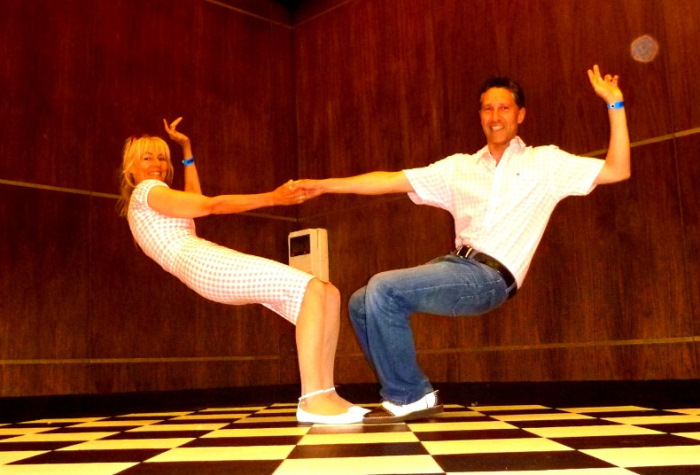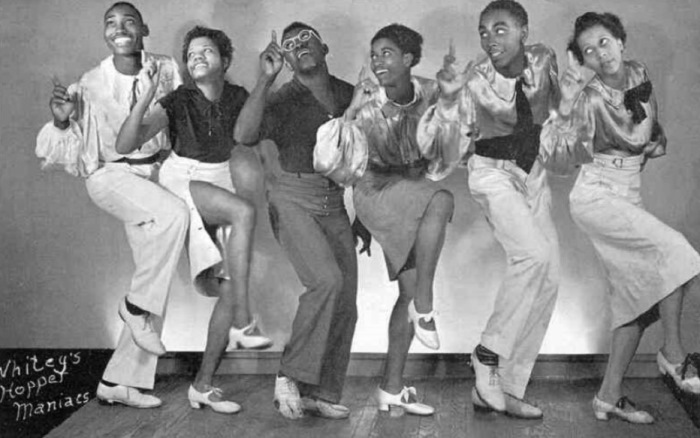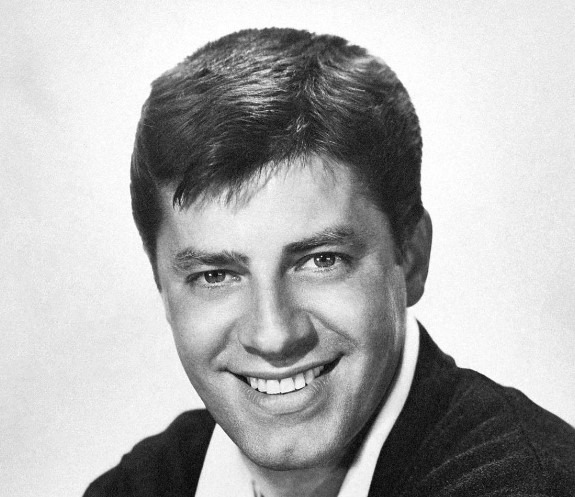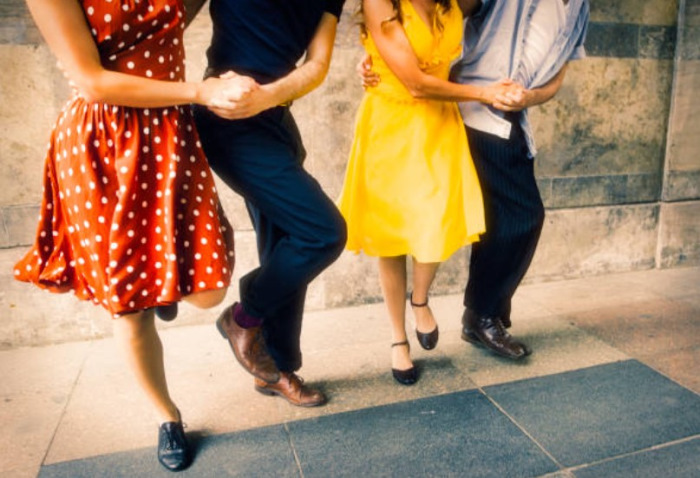During the Swing Era (1933-1947), the Jitterbug dance was all the craze.
For the uninitiated, the Jitterbug dance may look quite strange with the dancers’ fast and jumpy (jittery) movements. But the dance – performed to fast-tempo swing or jazz music – swept across the country in the 1930s and even got itself a venerable audience abroad in Europe.
But who exactly invented the Jitterbug dance?
This question has been the subject of much debate and speculation over the years. Even today, as far as we know, dance historians still haven’t managed to come to a consensus just yet. The only thing that we know for certain is that the Jitterbug came to being in African American juke joints and dance halls.
But no worries. In this article, we will take a closer look at the history of the Jitterbug dance. Specifically, we’ll dive in and explore the various theories about its origin to help you understand this iconic and beloved dance better!
Table of Contents
What Is The Jitterbug Dance?
The Jitterbug dance is considered a type of swing dance and enjoyed its heyday through the Swing Era (1933-1947) and beyond. The dance is characterized by its high-energy movements, fast footwork, and dynamic turns and spins.
But most notably, jitterbug dancers tend to perform with very janky, erratic body movements (almost like they’re drunk.)
It’s why the dance is called the “Jitterbug”: the dancers look like a flock of jittering bugs!
Usually, a jitterbug dance is performed to upbeat swing music, such as jazz and big band. You can dance solo, with a partner, or in a large group as you see fit.
Jitterbug Origin & History
The exact origin of the Jitterbug dance is somewhat of a mystery and is the subject of much debate and speculation. Nobody knows who was the first to come up with the dance. But what reliable records we have about the Jitterbug showed that it – like many other swing dance variations – came from out of the Savoy Ballroom in the Harlem side of New York City.
The most widely accepted theory said that during the time of racial segregation, white and colored dancers had to go to different venues to dance. But there were many ballrooms across America at the time that didn’t practice racial discrimination … among which was the Savoy Ballroom.
Here, white dancers learned how to dance the Lindy Hop (another popular swing dance form). Because they were new to the fast and energetic dance style of swinging, black patrons ridiculed them by calling them “Jitterbugs” because they looked stilted and jumpy “like jittering bugs.”
Over time, the term “jitterbug” went from being a derogatory term to an actual name that people use to refer to the jumpy, jittery dance that later turned out to be super popular!
So, when was the Jitterbug dance popular?
The term “jitterbug” (along with “Lindy Hop”) became popular outside of the Harlem area thanks to Hollywood movies and Broadway productions.
Particularly, much of the credit for popularizing these terms has to be given to the Whitey’s Lindy Hoppers – a swing dance performance group who toured the country until 1942, when most of the members were drafted to war.
In the World War II era, American troops brought swing dancing (jitterbug included) to Europe. First, in Britain, where the dance caught on among the wider public despite discouragement from the British upper classes, who described it as “rude American dancing.”
By 1945, the jitterbug had already spread to France, becoming a craze in Great Britain. In the same year, the jitterbug dance was considered a kind of competition dance in Australia!
Unfortunately, nothing lasts forever. As the Swing Era whizzed by and swing dancing became popular, the feverish popularity of the Jitterbug dance also waned.
Fortunately, it’s never gone out of style completely. Even today, there were still clubs specializing in swing and jitterbug dancing!
Jitterbug Dance Steps
Because the Jitterbug dance was devised as a type of social dance, it’s not complicated to learn at all.
You don’t necessarily have to join any classes to get the hang of it (although classes are available). All you need to do is spend a couple of evenings practicing the basic motions. And then you can confidently come to a ballroom and show off your skill!
The Jitterbug Basic
The basic Jitterbug dance steps are best learned with a partner. So ask a friend to go along with you. Or, if you can’t find anyone in a pinch, it’s okay to practice in front of the mirror.
- Start by facing your partner with your hands clasped in front of you.
- On the second count, together, press into each other’s hands to step back. The lead should step back with their left foot, while the follower should step back with their right.
- For the third count, gently pull each other’s hands to come closer, stepping forward with the opposite foot.
This combination of counts two and three are known as the rock step.
- Next, the leader takes a step and leans to the left, while the follower steps and leans to the right. Then, reverse the motion: the leader steps and leans to the right as the follower steps and leans to the left.
- Repeat counts two through five as desired, with a rhythm of quick, quick, slow, slow.
Triple Steps
Confident that you got the basic steps down? Now onto something a little bit more complex and fast: the triple steps.
But don’t worry; you don’t need to learn anything new. It’s exactly like the Jitterbug Basic, but instead of doing it in four counts (steps), we’re now doing it in eight!
If you’re the leader, just remember the following pattern: rock step, left, right, left, right, left, right.
And for the follower: rock step, right, left, right, left, right, left.
Underarm Turn
Looking for a move that adds flair to your Jitterbug performance? The underarm turn is a simple, yet extremely effective move.
- Start just like you would with the Basic by facing your partner with your hands held together in front of you.
- On the second count, perform the rock step as normal. Press into each other’s hands to step back, pull each other’s hands to come closer. Then cap it up by stepping forward with the opposite foot.
Once you’ve finished the rock step, it’s time to execute the turn!
- The leader will step out to their left and raise their left hand to the side, guiding the follower to step out to their right and raise their hand rightward.
- The leader will shift their weight onto their right foot and guide their partner with a clockwise circle over their head, leading them to move their left foot across their body and make a half turn to the right.
- Finally, the leader should complete the circle and lower their partner’s hand, initiating another rock step at an angle from each other.
Inside Turn (Tuck Turn)
The Inside Turn (also called the “Tuck Turn”) is one of the most famous Jitterbug dance moves. But the Tuck Turn is present not just in Jitterbug, but also in the choreography of other swing variations like the Lindy Hop.
Anyway, the Tuck Turn is easy to learn and will incorporate the Triple Steps.
- Start by facing each other and execute a rock step.
- The leader should then release the partner’s left hand and lead them forward.
- Both partners then perform the first half of the triple step as the leader draws a counter-clockwise circle over the partner’s head and moves out of the way. This will give the follower the space needed to make a turn in front of the leader.
- Finally, perform the second half of the triple step, coming back in front of each other once more.
Famous Jitterbug Dancers
Many swing legends are known for their Jitterbug performances. Here are two names you need to learn about if you’re interested in the history of this dance!
Whitey’s Lind Hoppers
The Whitey’s Lind Hoppers was credited as the group that brought the term “Jitterbug” and “Lindy Hop” to the broader public through their appearances on Broadway shows and national and international tours.
They also appeared in some Hollywood movies, like A Day at the Races (1937) and Hellzapoppin’ (1941).
Founded by Herbert “Whitey” White, the swing dance troupe rose to fame in the 1930s and 1940s. It’s a group of some of the best swing dancers of the time to perform and compete in various venues across the United States.
Whitey’s Lindy Hoppers had a profound impact on the swing dance scene and played a significant role in popularizing the dance form. Other than being the driving force behind the popularization of swing dancing, some of their choreographies were co-opted into swing dancing and are still being done today.
The group disbanded in 1942 when male members were called into service due to World War II.
Jerry Lewis
Jerry Lewis was an American comedian, actor, and filmmaker. Over several decades, Lewis starred in 60 movies and directed 13 films. Many of his comedic productions were so good that many have anointed him as the “King of Comedy.”
However, besides being known for his witticisms and humor, Lewis was also a skilled dancer. He performed the Jitterbug dance in many films (like in this clip) and used the high-energy, jittery moves to show off his dancing talent and physical abilities and as a kind of terpsichorean “punchline” for his jokes!
Today, Jerry Lewis is still remembered as one of the greatest comedians of his era. And while not many people know (or appreciate) his excellent swinging skill, people still appreciate his contribution to comedy and popular entertainment all the same.
Jitterbug Dance Music
The Jitterbug, of course, is often danced to swing music and jazz.
Swing music was often performed by big bands, which consisted of multiple horns, percussion instruments, and a rhythm section. The fast tempo and rhythmic nature of the music make it perfect for the jitterbug.
In addition to swing music, other music types often associated with the jitterbug dance include jazz, blues, and rock and roll. Just like swing, they feature rapid tempo and clear rhythms that make dancing the Jitterbug easier.
If you want to hear some recordings, check out the sounds of the most famous swing musicians at the time, like Duke Ellington, Count Basie, and Benny Goodman.
Jitterbug Dance Clothes
When getting dressed for a Jitterbug dance session, both today and in the 1930s and 1940s, dancers of country Jitterbug dances always opt to wear comfortable clothes that allow for a full range of movement.
During the Swing Era, men often wore suits, slacks, and dress shirts. Women wore dresses or skirts with blouses. All are very vintage and traditional.
In modern times, fashion’s a bit more diverse and loose. A lot of people have this notion that all Jitterbug events will enforce a strict dress code to suit the 1930s-1940s theme, and everyone has to come wearing either suits or dresses. That’s far from the truth.
Modern Jitterbug dance events typically don’t have a strict dress code. Dancers can wear whatever they want (so long that it’s suitable for the public).
Female dancers will wear a dress or skirt with a fitted top, while men may wear slacks and a collared shirt. Some may show up in sweatpants or track pants and t-shirts. That’s fine (if the establishment doesn’t enforce a dress code).
Comfortable shoes with low heels and good traction are important for jitterbug dancing. Shoes with leather soles are generally preferred, as they provide a good grip on the dance floor and allow for a smoother slide across the floor.
FAQs
Now that we’ve answered the main question, here are some extra questions about the Jitterbug posed by our readers!
1. What is the difference between swing dancing and jitterbug?
“Swing dancing” and “Jitterbug” are often used interchangeably, but there’s a big difference between them.
Swing dance is an umbrella term that refers to a collection of dances, ranging from the Lindy Hop, the Charleston, and the Jive, to the Jitterbug. So, the Jitterbug is a subset of swing dancing.
They’re one and the same. Just that “swing dancing” encompasses several other dances compared to Jitterbug, a more specific dance style.
2. What is the difference between Jitterbug and Lindy Hop?
Jitterbug and Lindy Hop are both swing dance styles that originated during the swing era of the 1930s and 1940s. Both are known to have originated from the Savoy Ballroom in Harlem, New York City.
But while the Jitterbug involves fast footwork and bouncy, high-energy movements, the Lindy Hop is a bit more complex, with lifts and tricks thrown into the choreography.
3. What is the difference between Jive and Jitterbug?
The Jive requires the dancer to bring their knees up high as they bounce around, which is a pretty unusual characteristic among different types of swing dance. And because the rhythm of the Jive is so fast (it’s among the fastest of all swing dances), the Jive is often performed in place.
That’s in stark contrast to the Jitterbug, whose dancers will waltz around the entire dance floor.
Final Words
So, while the true origin of the Jitterbug is not known (and quite possibly will never be known), its history is interesting. While it’s no longer quite as popular today, if you’re interested in giving it a shot, plenty of studios, classes, and festivals can give you the full-swing dancing experience!
We hope this article has been informative for you.
What do you like most about the Jitterbug dance or swing dancing in general? Tell us in the comments!



